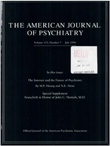Antidepressant-associated mania: a controlled comparison with spontaneous mania
Abstract
OBJECTIVE: Antidepressants have been associated with the induction of mania and rapid cycling. This study examined whether antidepressant- associated manic states differ in any way from spontaneous mania. METHOD: Forty-nine consecutive inpatients with antidepressant- associated manic states were compared with 49 matched inpatients with spontaneous mania in a blind, retrospective chart review. RESULTS: Across virtually every clinical measure examined, the patients with antidepressant-associated manic states experienced milder and more time- limited manic episodes than the patients with spontaneous mania. The patients with antidepressant-associated manic states were subject to frequent checking by nurses and hall restriction for a significantly shorter period of time than the patients with spontaneous mania. The patients with antidepressant-associated manic states also had significantly less severe levels of delusions, hallucinations, psychomotor agitation, and bizarre behavior, according to a standard rating instrument, than the patients with spontaneous mania. For further study the patients with antidepressant-associated mania were divided into subgroups taking four individual classes of antidepressant drugs: tricyclics (N = 19), fluoxetine (N = 13), monoamine oxidase inhibitors (MAOIs) (N = 8), and bupropion (N = 6); three patients taking combinations of drugs were not included in these analyses. The patients with MAOI- and bupropion-associated mania had a slightly lower overall rating of severity of psychopathology at admission than the subgroups with fluoxetine- and tricyclic-associated mania. CONCLUSIONS: Antidepressant-associated mania appears to be a milder and more time- limited syndrome than spontaneous mania and may represent a distinct clinical entity. MAOIs and bupropion may be associated with milder manic states than either tricyclic drugs or fluoxetine.
Access content
To read the fulltext, please use one of the options below to sign in or purchase access.- Personal login
- Institutional Login
- Sign in via OpenAthens
- Register for access
-
Please login/register if you wish to pair your device and check access availability.
Not a subscriber?
PsychiatryOnline subscription options offer access to the DSM-5 library, books, journals, CME, and patient resources. This all-in-one virtual library provides psychiatrists and mental health professionals with key resources for diagnosis, treatment, research, and professional development.
Need more help? PsychiatryOnline Customer Service may be reached by emailing [email protected] or by calling 800-368-5777 (in the U.S.) or 703-907-7322 (outside the U.S.).



